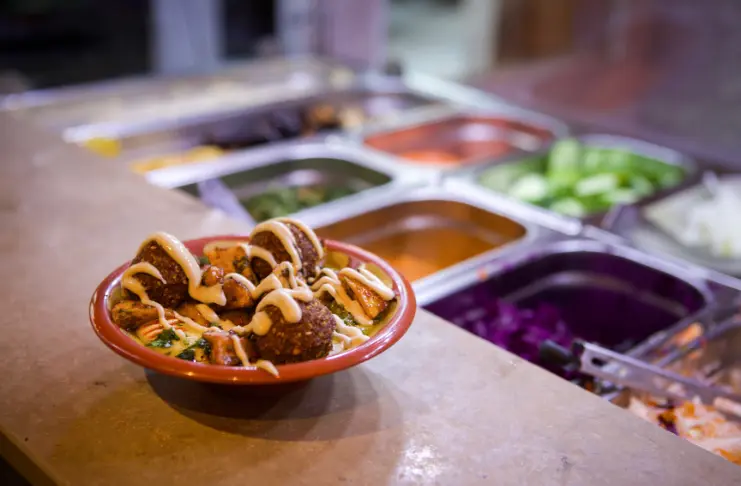
Vegetarian chain restaurants are gaining ground and not just as an ethical or health-conscious choice. Instead, vegetarian restaurants are building their own space, supported by consistent consumer demand, menu shifts, and strong performance across urban and suburban markets.
As a result, restaurants and chains offering plant-based or vegetarian-forward menus are scaling faster with higher repeat visits, capturing the attention of health-conscious and wellness-focused diners, especially among the younger demographics.
This blog breaks down the key vegetarian chain restaurant statistics behind this growth. From market size and customer trends to demand patterns and menu analytics, it outlines how vegetarian chain restaurants are carving out a scalable, sustainable path in foodservice and what that means for operators looking to stay competitive.
How Big Is the Vegetarian Restaurant Market?
In foodservice, plant-based and vegetarian offerings are one of the fastest-growing segments, with restaurant menus increasingly incorporating meatless options, for niche diners as well as broader audiences seeking variety and health-conscious choices.
Globally, the vegetarian food market size is expected to be at $34.1 billion by 2024 and grow at a CAGR of 10.9% from 2024 to 2031. Herein, North America is the leading market in plant-based foodservice today, with sales at nearly $9.87 billion in 2024, rising at an 11.7% CAGR to reach $26.7 billion by 2033.
This reflects a major shift in demand from both dedicated vegetarian consumers and flexitarians seeking plant-forward dining options.
Factors Driving the Growth of the Vegetarian Restaurant Market
The popularity of vegetarian restaurant chains has grown steadily over the past few years, because of changing eating habits, new expectations, and an increased push towards sustainability. Here are five key reasons why this segment is seeing growth-
1. People are Shifting to Less Meat
A growing number of consumers are cutting down on meat, even if they don’t identify as vegetarian. This shift, often referred to as flexitarianism, is now common across all age groups. People want more vegetarian and plant-based options when eating out, and they want them to be satisfying and accessible. Chains that position themselves as vegetarian-first but inclusive are capturing this demand by designing menus that cater to everyone without compromising identity.
2. Consumers Have Higher Expectations
Younger consumers are holding restaurants to higher standards. They’re looking for sustainability, ingredient traceability, and ethical sourcing, and they’re willing to spend more on brands that meet those expectations.
Vegetarian chains have a natural advantage here, particularly those that lead with transparency and align with climate-conscious values. For chains targeting long-term brand affinity, these demographics are key.

3. Health-Conscious Diners Are Driving Repeat Visits
The link between diet and wellness is driving purchasing habits across income levels. Consumers who prioritize gut health, weight management, or chronic disease prevention often view vegetarian food as the safer, default option. Chains that focus on whole foods over processed meat substitutes, and promote clean-label or allergen-friendly menus, are building strong loyalty among this group.
4. Smarter Ingredient Sourcing
From a back-of-house perspective, vegetarian menus offer operational flexibility. With no raw meat to handle, prep becomes simpler, plus, ingredients can be used across multiple dishes, which helps reduce waste and streamline inventory.
Many vegetarian chains are also shifting to local, seasonal sourcing as a way to control costs and build more agile supply chains.
5. Global Cuisines Are Making Vegetarian Food More Accessible
The rise of globally inspired menus, such as Indian, Middle Eastern, and Asian cuisines, has changed how vegetarian food is perceived. These cultures naturally offer a variety of vegetarian food options without relying on processed substitutes for meat.
Restaurant chains that incorporate this diversity are enhancing appeal across cultures and dietary habits, creating menus that are inclusive without compromising on flavor or quality.
EXPERT OPINION
Rob Morasco, CEC, senior director of culinary development at Sodexo USA, talks about the driving factors of increasing vegan and vegetarian options in his company. “In talking about trends, for us it really all starts at the university level, and that’s certainly true with plant-based. But it’s rapidly pushing into other parts of the business too — hospitals, corporate dining, even senior living foodservice.
Everything around plant-based, including sustainability, is the number-one trend right now. It’s not going to stop. I believe we’re going to get to ‘one for one’ — for every conventional, animal-based protein item on regular menus, you’ll see an equivalent option that’s plant-based. Already, most of our menus run between 25 percent and 35 percent of entrees being either vegan or vegetarian.”
Vegetarian Restaurants: Segment-Wise Growth
Vegetarian and plant-forward dining is flourishing across multiple segments of the restaurant industry. Here’s how-
A. Quick-Service Restaurants
QSRs have played a leading role in bringing plant-based dining to the mainstream. While traditional chains have integrated vegetarian options, fully plant-based QSRs are scaling fast. As of mid‑2022, plant-based proteins were present on 31.5% of QSR menus, with a 4.1% year‑over‑year growth rate. This reflects increased adoption by traditional QSR chains and the rise of vegetarian-first concepts.
Hart House, launched by comedian Kevin Hart, opened its fourth outlet in 2023 and introduced its first drive-thru location, positioning itself to compete with mainstream QSR giants.
B. Fast Food Chains
Plant-based concepts are gaining momentum through convenience-driven models such as fast food chains. For example, Next Level Burger, a plant-based fast food restaurant chain, currently operates across 9 locations and has raised $20 million with the long-term goal of scaling up to 1,000 units.
These chains prioritize accessibility and speed while sticking to entirely meatless menus, appealing especially to flexitarians and Gen Z consumers.
C. Fast-Casual Chains
Fast casual is where plant-forward concepts thrive not just in menu popularity, but also in unit economics and innovation. Chains in this format offer consumers control: build-your-own bowls, seasonal produce, and customizable protein choices. That flexibility translates into higher average checks and repeat traffic.
One standout example is Cava Group, which nearly doubled its footprint from 164 to 323 restaurants between 2022 and 2023, with 58 new openings in 2024 alone and plans for over 60 more in 2025. They deliver 13.4% same-store sales growth and maintain an impressive 25% restaurant-level profit margin, all while bringing average unit volume close to $2.9 million annually.
D. Full-Service Restaurants
Full-service vegetarian restaurants are expanding steadily, particularly in the premium casual and wellness-focused dining space. True Food Kitchen, which features a largely plant-forward menu, now operates 46 locations across the U.S. and has secured over $100 million in investment to fuel its national expansion.
Similarly, upscale vegan food concepts like Planta have gained momentum in major metro areas, contributing to the visibility and appeal of high-end vegetarian dining. As demand for holistic wellness and sustainable eating grows, full-service vegetarian formats are carving out a stronger presence in the market.
Vegetarian Chain Restaurant Statistics: Consumer Behavior and Trends

Understanding who is choosing vegetarian meals, and why, is key to shaping a successful growth strategy in this category. Today’s demand is increasingly fueled by health-conscious diners and younger consumers seeking variety and balance. Let’s look at how consumer behavior and demand are changing the face of the vegetarian restaurant industry-
- 54% of U.S. adults eat vegetarian meals sometimes or always when dining out, including 6% who follow a vegetarian diet all the time, and 3% who consider themselves vegans.
- 25% of U.S. adults report eating vegan meals sometimes or always when eating out.
- 16% of vegetarians and 15% of vegans dine out weekly at restaurants (comparable to omnivores at ~14%), showing high engagement despite dietary restrictions.
- 25% of vegetarians and vegans visit fast casual venues weekly, compared to 18% of the general population.
- Nearly 48% of vegetarian/vegan diners say a “healthy menu” is a top priority when choosing a restaurant, vs. 27% of general diners.
- Only 50% of vegetarians and 45% of vegans rely on social media to discover new restaurants, while 45% of vegans check online reviews, as compared to 37% of those who eat meat.
- 59% of U.S. households purchased plant‑based foods in 2024, and 79% of those repeat-purchased, showing strong retention in plant-based buying behavior.
- Industry research shows consumers aged 18-34 are the most likely to order vegetarian menu items, with around 30% reporting a vegetarian entrée at least once every 90 days.
- 21% of vegetarians and vegans dine at fine dining venues weekly, more than double the 9% rate among all adults.
Menu Trends in Vegetarian Chain Restaurants
The following trends capture what’s resonating with diners and enhancing operational efficiency for vegetarian chain restaurants-
1. No Meat Replacements
Leading vegetarian chains are shifting away from imitation meats and toward whole‑ingredient dishes where vegetables, grains, and legumes play starring roles. For instance, brands emphasize items like charred cauliflower steaks, grain bowls, and edamame dumplings over products like plant-based burgers.
For instance, True Food Kitchen, which operates a largely plant‑forward menu, has built its reputation on clean, scratch‑kitchen dishes rooted in anti‑inflammatory diet principles, not processed meat substitutes
2. Clean-Label and Nutritional Transparency
Consumers now expect clean ingredients and clear nutrition. A global market analysis of vegetarian food highlights rising demand for clean-label products—non-GMO certification, added fiber, probiotics, and high protein from sources like quinoa and chickpeas. For chains, labeling allergen-free, gluten-free, or non-GMO on menus builds credibility and loyalty.
3. Build-Your-Own Bowls and Global Flavors
Customizable bowl meals are a big hit. Whether it’s a rice bowl, grain bowl, or noodle bowl, diners like being able to mix and match ingredients to suit their tastes and dietary needs. Many chains are also adding global flavor profiles, like Mediterranean, Southeast Asian, or Indian spices, to keep things exciting. This trend not only appeals to experimental eaters but also keeps menus fresh and flexible.

4. High-Protein Vegetarian Meals
Consumers are looking for protein-rich vegetarian options that keep them full and offer better alternatives for meat-based proteins. Chains are responding by highlighting ingredients like lentils, chickpeas, tofu, paneer, quinoa, and black beans in protein-forward meals. According to a report, 25% of U.S. consumers would order more plant-based dishes if they clearly listed nutritional values, such as sugar and protein content.
5. Clean and Whole‑Food Menus
Menus are shifting toward simpler, recognizable ingredients and away from ultra-processed foods. Plant-based menus marked by whole foods and natural ingredients are gaining credibility and consumer trust, while decreasing reliance on meat analogues or artificial additives.
In fact, over the next two years, over 70% of food and beverage manufacturers in Europe plan to make clean-label products a core part of their portfolios, up from around 52% in 2021, clearly demonstrating high demand for cleaner food.
Technology and Innovation in Vegetarian Chain Restaurants
1. Online Ordering and Delivery Integration
Delivery has reshaped customer expectations. A National Restaurant Association report found that 75% of restaurant sales now come from off-premise orders, with speed cited as critical by 95% of consumers, especially among Gen Z and Millennials.
Vegetarian chains that streamline digital ordering via websites, apps, and aggregators can tap into this cultural shift toward fast, convenient meals. Plus, integration with platforms like DoorDash and Uber Eats is now table stakes for scaling delivery operations.
2. Contactless Ordering and QR Menus
QR-based ordering and contactless payment became mainstream during the pandemic and remain a fixture in fast-casual vegetarian brands. Contactless dining not only speeds up service but also eliminates reliance on staff and improves hygiene perception.
It further allows vegetarian chains to deliver transparent digital menus and seamless checkout, enhancing both margins and customer trust.
3. Technology for Ingredient-Level Transparency
Consumers expect clarity about what’s on their plates. Vegetarian chains are turning to technology, like QR menus, digital allergen filters, and sourcing trackers to share detailed nutrition and ingredient origin data in real time. This boosts consumer confidence and supports premium pricing based on transparency and brand integrity.
Operators that offer clear insights into ingredients or nutritional content (e.g., non-GMO, organic, allergen-free) are more likely to retain value-conscious diners.

4. Delivery‑First Models
Vegetarian QSRs and fast-casual brands are using cloud kitchens to expand rapidly and cost-efficiently. Ghost kitchens eliminate storefront costs and enable brands to focus on delivery zones with high vegetarian demand.
Within this, North America dominates the virtual-restaurant space, benefiting brands that optimize delivery-only footprints. Scalability is further supported by shared-use kitchen tech stacks and real-time demand forecasting.
5. Loyalty and Menu Personalization
Top vegetarian brands are building loyalty around wellness values and dietary preferences. Many use digital analytics to recommend meals based on past behavior, generate offers tied to health-focused goals, and personalize loyalty rewards.
For example, Sweetgreen, a fast casual restaurant chain serving salads, has deployed its “Infinite Kitchen” concept with automation and data-driven customization to offer a personalized dining experience to its customers.
Future Outlook: What’s Next for Vegetarian Restaurant Brands?
Looking ahead, vegetarian restaurant formats are positioned for continued growth, driven by consumer shifts, evolving delivery formats, and emerging markets.
1. Accelerating Growth in Vegetarian Menus
A recent study by the Plant Based Foods Association (PBFA) and the Good Food Institute shows plant-based menu items have increased by 62% over the past decade, and are now available in 48.4% of U.S. restaurants.
At the same time, nearly one-third of operators surveyed plan to expand their plant-based offerings. These figures suggest that vegetarian dining is becoming mainstream across foodservice formats, including vegetarian-dedicated chains.
2. Flexitarians Will Power Demand
Reports show that around 47% of U.S. consumers identify as flexitarian, with significant growth seen among Millennials and Gen Z, who drive demand for vegetarian meals even if they still consume meat occasionally.
Baby Boomers are also driving demand, increasingly opting for vegetarian options to manage health conditions like heart disease and metabolic issues.
3. Menu Evolution
Plant-based meat analogs made up 53% of plant-protein pound sales in 2022, rising from 39% in 2019. Meanwhile, non-analog vegetarian meals, built around ingredients like tofu, legumes, and fresh vegetables, are also gaining ground.
As a result, many restaurant chains are now shifting focus toward whole-food options, prioritizing taste, authenticity, and cost-effectiveness over processed substitutes.
4. Expansion Into New Markets
Foodservice operators are actively investing in vegetarian concepts to cater to an ever-changing consumer market. For instance, multiple fast-casual chains have merged or expanded into Tier-2 and Tier-3 city markets to capture underserved demand.
Next Level Burger acquired Veggie Grill in 2024 to deepen its presence beyond West Coast urban hubs. The combined company now spans seven states, including California, Oregon, Colorado, New York, Texas, Washington, and now Massachusetts, too, with the expansion.
Further, PBFA reports that 76% of operators expect plant based meat offerings to be stable or growing, showing widespread confidence in the category’s longevity.
Conclusion
Vegetarian dining is no longer limited to a niche audience. It’s now becoming a shared preference across age groups, regions, and eating habits. For restaurants, this means the opportunity lies in expanding menus, but more importantly, in determining how plant-based food options are positioned and experienced.
Offering satisfying, well-executed vegetarian meals can drive repeat visits, improve margins, and future-proof the brand as food choices continue to shift toward health, sustainability, and variety.
Frequently Asked Questions
Yes, a study found that approximately 84% of individuals who adopted vegetarian or vegan diets eventually returned to eating meat. The reason behind this included dissatisfaction with vegetarian food, inconvenience, cost, and lack of motivation.
As of 2024, there were 32,288 vegetarian and vegan restaurant businesses in the U.S., an increase of 2.8% from 2023 and accounting for a modest share within the broader foodservice industry.
In 2024, the U.S. had approximately 32,300 vegetarian and vegan restaurants, a 2.8% increase over the previous year. This includes both independent and chain formats, but remains a small fraction of the overall restaurant count.
About 4% of U.S. adults identify as vegetarian and 1% as vegan, according to Gallup. While these numbers haven’t changed much over the years, a far larger share of Americans are cutting back on meat for multiple reasons, such as health, sustainability, or personal preference.








